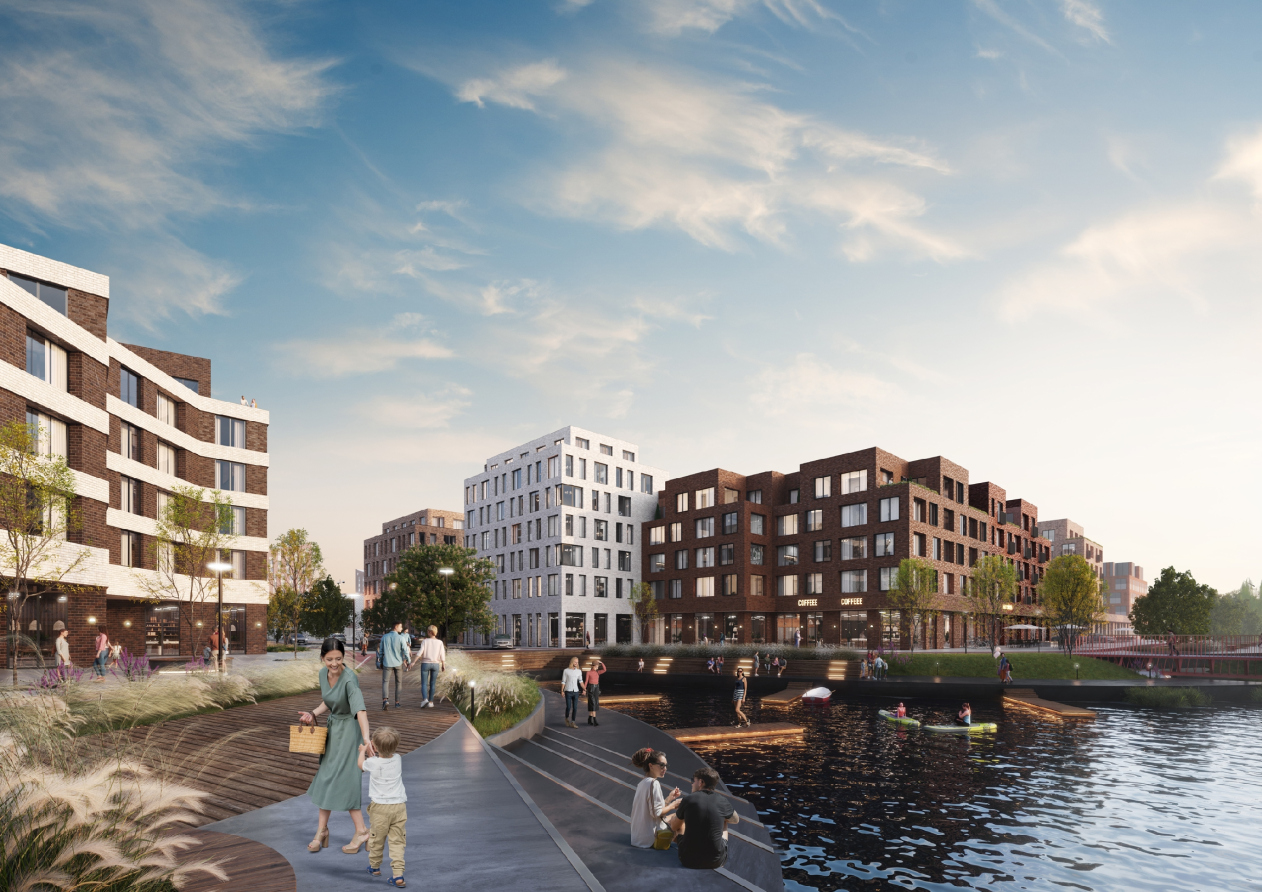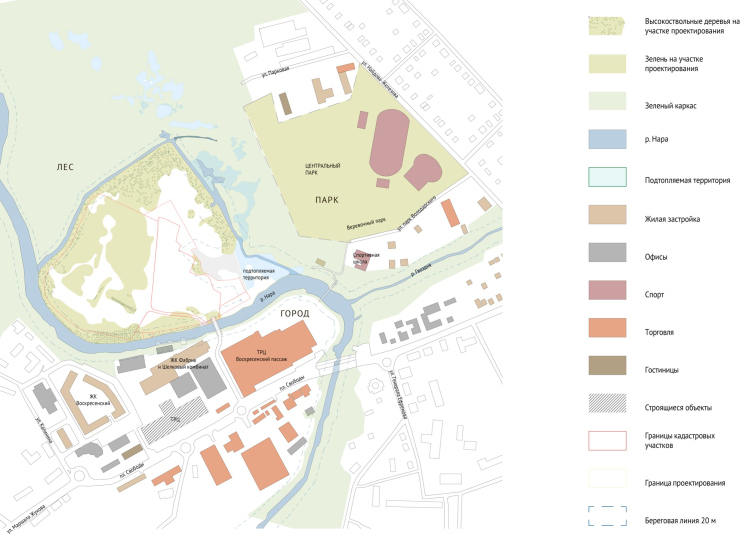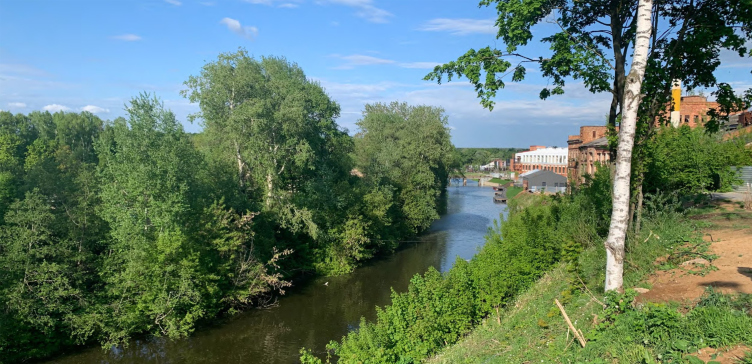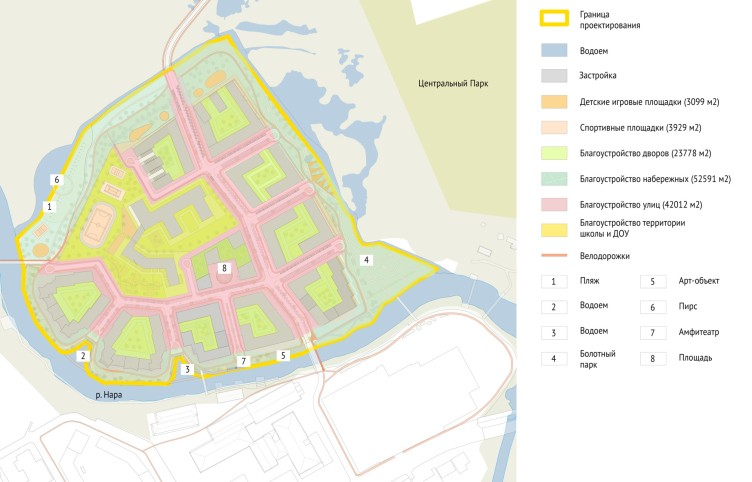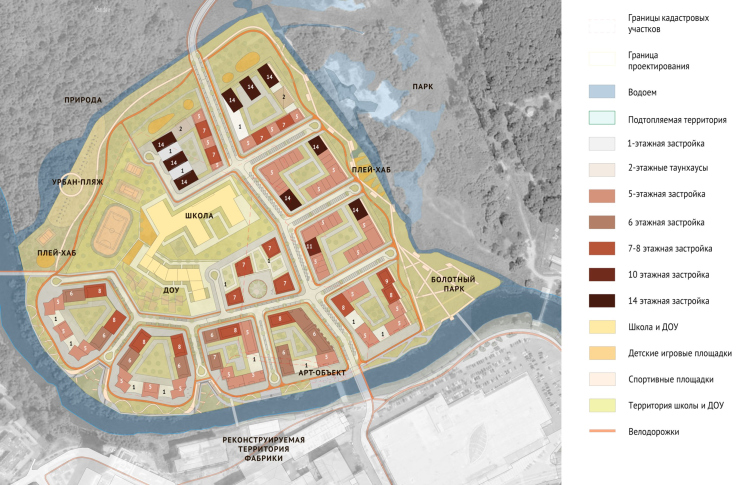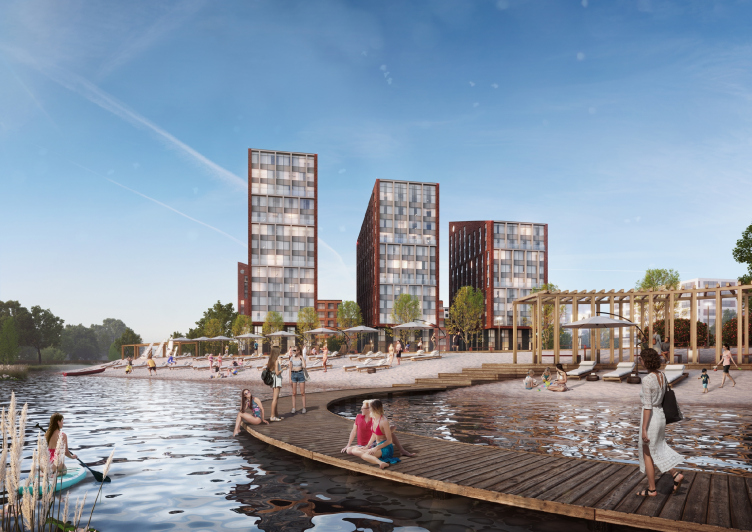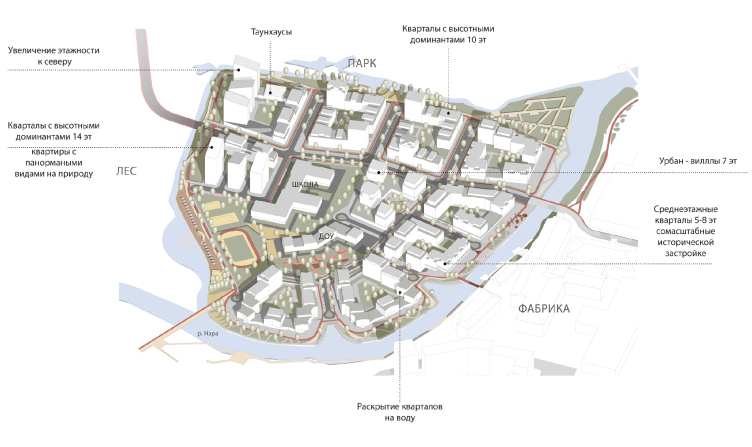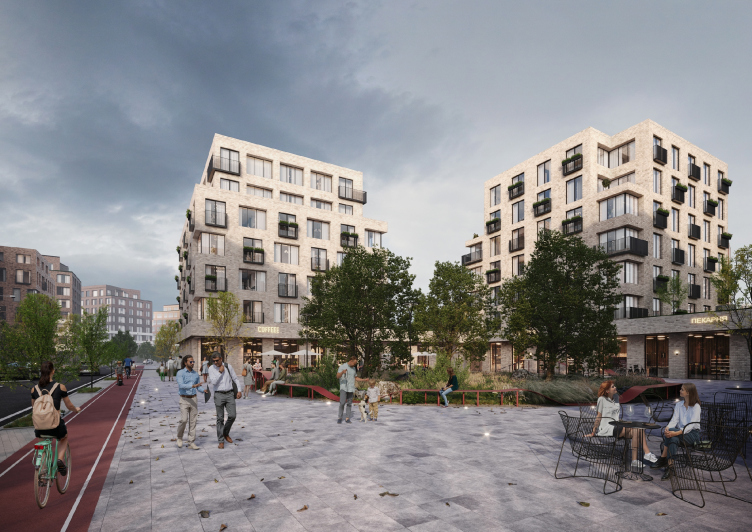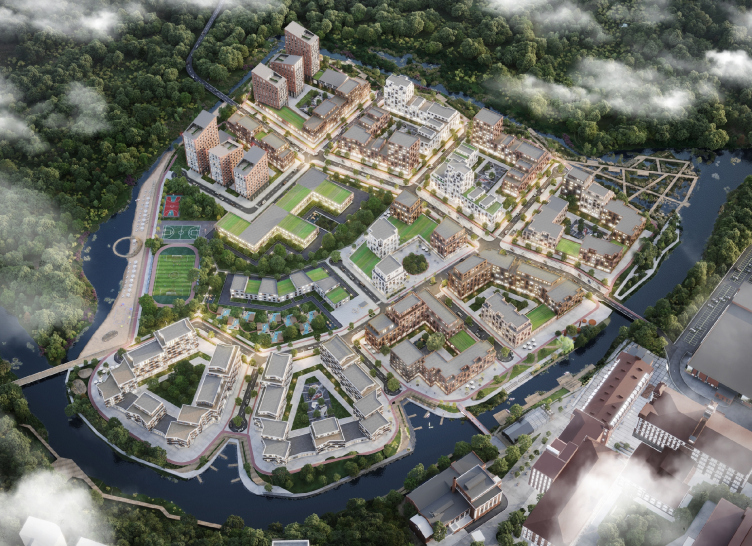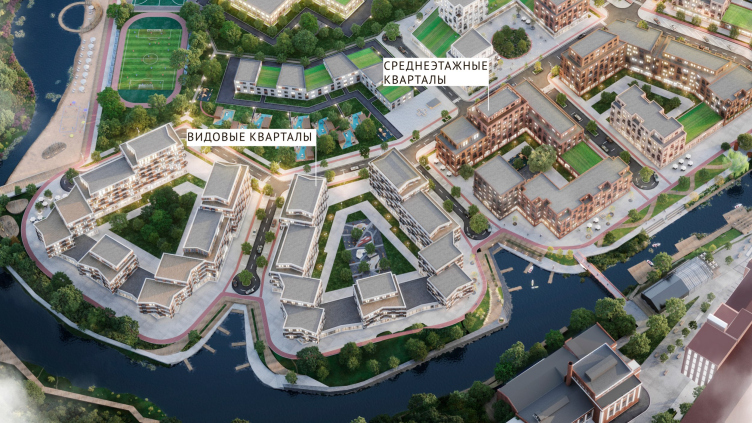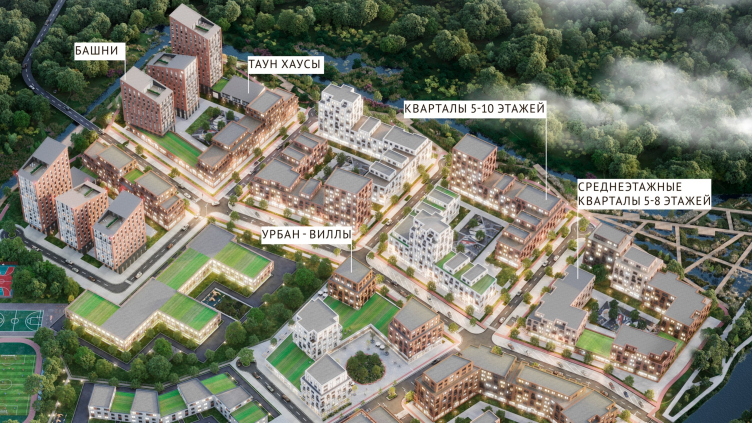Moreover, in its central part, a project of integrated territory development is now unfolding. Both the clients – Ostrov Group – and the authors – DNK ag architects – are justly proud of it.
The process began back in 2018, when there was no concept of “integrated territory development” yet, but many people were already working on master plans for urban development, and the terms “comfortable living environment” and “transformation of industrial zones” already meant something. Then the Ostrov Group started redeveloping the silk-weaving factory, around which, in fact, Naro-Fominsk, the union of two working villages, had been formed at the end of the XIX century. The factory was abandoned, and the project of its revitalization, now largely completed, was entrusted to the Dutch bureau Mei architects and planners.
Igor Shapovalov, leader of Ostrov Group
We have been working in Naro-Fominsk for a long time, striving to handle this city, especially its center, carefully and attentively. In 2012, we accepted the proposal of the city’s mayor and, together with architect Ilya Zalivukhin, developed a master plan for the development of Naro-Fominsk. We engaged in sociology and big data. I must say that I was already very passionate about modern urban trends back then – concepts like the 15-minute city and a comfortable urban environment.
The territory of the factory and the island is crucial for the city; it is located right in the center but it had long divided it. We started working with the abandoned industrial zone and gradually returned it to the city. For several years now, we have been systematically restoring and preserving historical buildings, “uncovering” them; they are interesting and beautiful, they are the history of the place, what makes the city unique.
One of our goals is for the factory not to divide but to unite the city. We have already opened public spaces on the right bank of the river, but there is still much to do, including a new thoroughfare. Another task is to make the city multifunctional and comfortable, convenient, diverse both in height and character of spaces. The third important thing is to reveal the river to the city. None of the townspeople had seen the river. We literally removed tons of garbage, worked to remove some discharges, including unauthorized ones, and restored the river’s ecology. A boating station is already in operation, and plans include docks, light watercraft, and the opportunity for city residents to fully utilize the river. So, I would say we are pioneers in many aspects in the Moscow region; we are being held up as an example. I’m pleased that the Chief Architect of the Moscow Region, Alexandra Kuzmina, actively supports our initiatives, and we discuss all projects with her.
The territory of the factory and the island is crucial for the city; it is located right in the center but it had long divided it. We started working with the abandoned industrial zone and gradually returned it to the city. For several years now, we have been systematically restoring and preserving historical buildings, “uncovering” them; they are interesting and beautiful, they are the history of the place, what makes the city unique.
One of our goals is for the factory not to divide but to unite the city. We have already opened public spaces on the right bank of the river, but there is still much to do, including a new thoroughfare. Another task is to make the city multifunctional and comfortable, convenient, diverse both in height and character of spaces. The third important thing is to reveal the river to the city. None of the townspeople had seen the river. We literally removed tons of garbage, worked to remove some discharges, including unauthorized ones, and restored the river’s ecology. A boating station is already in operation, and plans include docks, light watercraft, and the opportunity for city residents to fully utilize the river. So, I would say we are pioneers in many aspects in the Moscow region; we are being held up as an example. I’m pleased that the Chief Architect of the Moscow Region, Alexandra Kuzmina, actively supports our initiatives, and we discuss all projects with her.
City on an Island. Urban planning analysis of the territory
Copyright: © DNK ag
Continuation of development
A logical continuation and the next step of Ostrov Group working with the factory and the city’s historical center will be a residential area on the Nara’s left bank – the so-called “island”, with an area of 19.27 hectares, situated between the factory and the city park. Throughout the 20th century, this territory lay undeveloped – it hosted a few warehouses, but essentially it was a wasteland. It received an “island” status because the extremely winding Nara River makes here another bend, and the land on its left bank was largely swamped – in order to drain it, they dug a channel that separated the “warehouse” wasteland from the forest, and the brook, which had separated it from the city park, had always existed.
Accordingly, the architects had to fulfill the following tasks: first, to develop ideas related to the revitalization of the factory, from the public spaces to the diversity of morphology and the interpretation of the district’s “central” location – and second, to maximize all the advantages offered by the water and natural environment.
Panorama of the island and the factory, view from the northeast side
Copyright: Photograph © DNK ag
DNK ag architects were invited to work on the concept of a new district in the center of Naro-Fominsk – it turned out to be that rare case when there was complete synergy between the client and the authors of the project.
The client’s wishes were formulated approximately as follows: canals, a strong emphasis on water, modern architecture, public spaces on the ground floors, a rich and diverse urban environment accessible to everyone – a human-scale environment, in short.
A professional challenge for us was the task of creating an environment that is atmospherically comparable to the historic part and includes the natural surroundings.
We had long wanted to do something like this. I’ll be straightforward; we dreamed of such a project. When we heard about it, we realized that it was the dream project, where the client wants to see everything that we consider right. From our perspective, this is the best type of development: medium-rise buildings with good, not overly wide proportions of all spaces. We were “on the same page” with the client – this is a great stroke of luck and rarity.
A professional challenge for us was the task of creating an environment that is atmospherically comparable to the historic part and includes the natural surroundings.
We had long wanted to do something like this. I’ll be straightforward; we dreamed of such a project. When we heard about it, we realized that it was the dream project, where the client wants to see everything that we consider right. From our perspective, this is the best type of development: medium-rise buildings with good, not overly wide proportions of all spaces. We were “on the same page” with the client – this is a great stroke of luck and rarity.
Connections, angles, and perspectives
One of the principles of historical development, as well as of modern urbanism, is that any district must be connected to its neighbors and must be accessed from different directions. This is why islands – think of Paris’s Île de la Cité – are usually strung along at least one urban artery. This is the way it happened here: the scale, of course, is smaller, but the principle is similar – a city street will pass through the island, and it will connect the city center and its main axial street with the highway leading to Kubinka and towards Minsk highway. The bridge over Nara, in place of the former factory bridge, is already under construction. The benefits are abundant, chief of them being development of the transportation framework, which Naro-Fominsk, as I know from my experience, badly needs – and this overcoming the “island” isolation. The automobile bridge will be supplemented by two pedestrian bridges for access to other parts of the city.
City on an Island. Scheme of landscaping and planting
Copyright: © DNK ag
City on an Island. The master plan
Copyright: © DNK ag
The city and water
Meanwhile, the island location is as much of an advantage as it is a challenge: there is plenty of space for recreation, there are beautiful river views, and you can breathe in the moist air, go boating, go swimming and fishing.
We all know that the exposure of a modern (i.e. postindustrial) city to the water, and removal of obstacles, created earlier by industrial parks, is one of the favorite, not to say cornerstone, themes of modern town planning. And, again, what we are seeing is a textbook example. The architects of DNK ag quote a Christopher Alexander book “A Pattern Language”:
“Our life grows weak if we cannot establish a full-fledged and steady contact with water. In most of the large cities, we are unable to do that”.
Grows weak? Well, maybe it does. But it should be emphasized that here we are seeing not just an embankment, but water on all sides, thin channels that need to be widened, a river that has already been cleaned, and a low-lying cape on which a Swamp Park with canopy walkways on supports is planned. Water-level boardwalks and amphitheaters, marinas, a beach and a “wild” natural shoreline for walking lie next to the tallest, 14-story houses in the northern part.
View of the city embankment from the side of the factory. City on the island
Copyright: © DNK ag
City waterfront. City on the island
Copyright: © DNK ag
Beach Recreation Area. City on an Island
Copyright: © DNK ag
Diversity
An important feature of the project is that it harmoniously combines both development and landscapes with different morphology: five or six types of urban construction within the framework of a reasonable number of floors ranging from 5 to 14.
This is also a sign of today’s urban planning: at some point, everybody grew seriously tired of endless repetition, and one’s eyes were eager for diversity. However, diversity (yes, pun intended) can also be extremely diverse – in this case what makes it different is the fact that it is carefully motivated by the specifics of the surroundings, the riverbank, and the landscape in general.
The riverside landscape of the Island is diverse, and in our project, we made an effort to capture and enhance this diversity. Both the embankments and the city blocks respond to it, reflecting the character of both the architecture and the landscape. Consequently, as you move through the area, the impressions formed by its environment will constantly change. We emphasized and intensified this by creating different scenarios and directions of movement. Streets were curved to increase the number of perspectives.
One of the “actors” in the development of the area, in our view, is Time: long-term development of the project is envisaged, and the planning structure laid out in it has the potential for further evolution. This aligns well with our proposed version of the urban environment, combining different morph-types of construction and street space.
One of the “actors” in the development of the area, in our view, is Time: long-term development of the project is envisaged, and the planning structure laid out in it has the potential for further evolution. This aligns well with our proposed version of the urban environment, combining different morph-types of construction and street space.
City on an Island. Axonometry
Copyright: © DNK ag
So, the development of the island that DNK ag is not just mid-rise and varied; it not only follows the rules of public floors and private courtyards, it’s more than that – the specifics of each fragment are built based on its location.
The school and kindergarten in the center form a large green spot, and the school stadium is adjacent to the beach. Closer to the factory quay, spaces with “urban” features are grouped together, forming a small square with short “urban villas” around it. Here is also a place for piers, a couple of bays, a boat station – since this is the side of the river, the other sides are still streams and canals, the river is larger. The river also provides panoramas, quite picturesque as it curves – so houses with the largest numbers of terraces on stepped roofs are clustered on this side.
Inner plaza and urban villas. City on an Island.
Copyright: © DNK ag
City on an Island.
Copyright: © DNK ag
City on an Island.
Copyright: © DNK ag
City on an Island.
Copyright: © DNK ag
In the northern and northeastern part, on the side of the forest and park, the height of the towers increases – up to 14 floors, and so does the “natural” character of the surroundings. It is easy to guess what this is done for: more residents will be “immersed” in nature.
City on an Island.
Copyright: © DNK ag
City on an Island.
Copyright: © DNK ag
City on an Island.
Copyright: © DNK ag
Now the sketch concept has been agreed upon and DNK ag are finalizing the first part of the detailed concept of the project. The client, both according to the architects and my personal impression, is serious about implementing the project and is proud of its position as an exemplary example of small town center transformation – one in which the words “integrated development” are taken seriously and literally.

